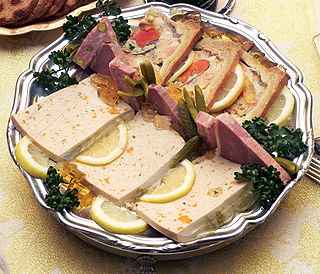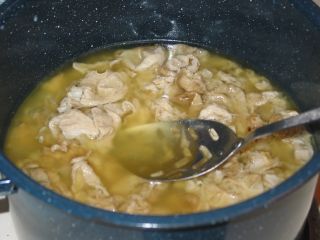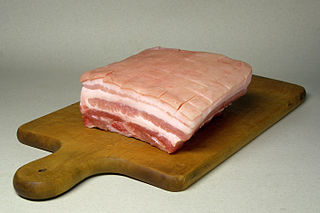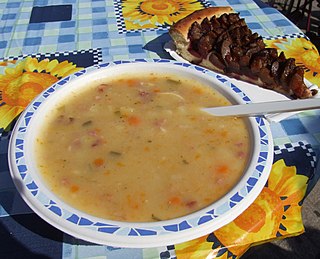
The cuisine of the Southern United States encompasses diverse food traditions of several subregions, including cuisine of Southeastern Native American tribes, Tidewater, Appalachian, Ozarks, Lowcountry, Cajun, Creole, African American cuisine and Floribbean, Spanish, French, British, and German cuisine. In recent history, elements of Southern cuisine have spread to other parts of the United States, influencing other types of American cuisine.

A sausage is a type of meat product usually made from ground meat—often pork, beef, or poultry—along with salt, spices and other flavourings. Other ingredients, such as grains or breadcrumbs, may be included as fillers or extenders.

Tripe is a type of edible lining from the stomachs of various farm animals. Most tripe is from cattle, pigs and sheep.

A blood sausage also known as a blutwurst sausage, is a sausage filled with blood that is cooked or dried and mixed with a filler until it is thick enough to solidify when cooled. Most commonly, the blood of pigs, sheep, lamb, cow, chicken, or goose is used.

Saumagen is a German dish popular in the Palatinate. The dish is similar to a sausage in that it consists of a stuffed casing; however, the stomach itself is integral to the dish. It is not as thin as a typical sausage casing. Rather it is meat-like, being a strong muscular organ, and when the dish is finished by being pan-fried or roasted in the oven, it becomes crisp.

Scrapple, also known by the Pennsylvania Dutch name Pannhaas, is a traditional mush of fried pork scraps and trimmings combined with cornmeal and wheat flour, often buckwheat flour, and spices.

Offal, also called variety meats, pluck or organ meats, is the internal organs of a butchered animal. The word does not refer to a particular list of edible organs, and these lists of organs vary with culture and region, but usually exclude skeletal muscle. Offal may also refer to the by-products of milled grains, such as corn or wheat.

Chitterlings, sometimes spelled chitlins or chittlins, are the large intestines of domestic animals. They usually come from pigs, but are also made from cow, lamb, goose and goat.

A ham hock or pork knuckle is the joint between the tibia/fibula and the metatarsals of the foot of a pig, where the foot was attached to the hog's leg. It is the portion of the leg that is neither part of the ham proper nor the ankle or foot (trotter), but rather the extreme shank end of the leg bone.

Peasant foods are dishes eaten by peasants, made from accessible and inexpensive ingredients.

Pennsylvania Dutch cuisine is the typical and traditional fare of the Pennsylvania Dutch.

Pork belly or belly pork is a boneless, fatty cut of pork from the belly of a pig. Pork belly is particularly popular in American, British, Swedish, Danish, Norwegian, Polish, Hispanic, Filipino, Chinese, Korean, Vietnamese, and Thai cuisine.
Soup beans is a term common in the Southern United States, particularly the regions around the Appalachian Mountains. Soup beans are usually served with cornbread, greens, and potatoes and may be topped with raw chopped onions or ramps. Soup beans are considered a main course, but also serve as a side dish. In rural areas, where food was scarce during the winter, these dried beans were a staple food.

Czech cuisine has both influenced and been influenced by the cuisines of surrounding countries and nations. Many of the cakes and pastries that are popular in Central Europe originated within the Czech lands. Contemporary Czech cuisine is more meat-based than in previous periods; the current abundance of farmable meat has enriched its presence in regional cuisine. Traditionally, meat has been reserved for once-weekly consumption, typically on weekends.

Dirty rice is a traditional Louisiana Creole dish made from white rice which gets a "dirty" color from being cooked with small pieces of pork, beef or chicken, green bell pepper, celery, and onion, and spiced with cayenne and black pepper. Parsley and chopped green onions are common garnishes. Dirty rice is most common in the Creole regions of southern Louisiana; however, it can also be found in other areas of the American South and referenced as "chicken and rice," "Cajun rice," or "rice dressing".
Chaudin, also referred to as ponce or Southern Louisiana Ponce, is a meat dish from southern Louisiana, US,. It is a sausage-like variant made from ingredients sewn up in a pig's stomach. The stuffing includes spices, pork, rice and vegetables including onions and peppers. It can be prepared in a Dutch oven, crock pot, or baked in an oven and is often sold smoked. It is often made with a Holy Trinity Gravy, a roux with brown chopped onion, bell pepper, celery and garlic in water, broth or wine.

The cuisine of the Palatinate region of Germany is essentially determined by regional dishes that have become popular throughout the whole region and even beyond.
















